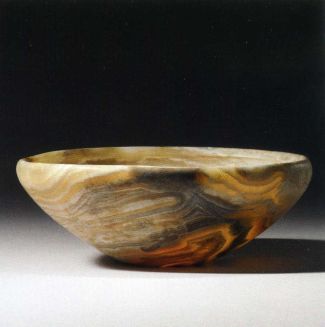Egypt and Egyptian antiquities, Pre and Early Dynastic Period (3100 - 2686 B.C.)
In the Predynastic period, there was no writing. During early Paleolithic times, Egypt was lush. Later, the climate changed and the desert expanded. Agriculture began, and there is evidence of small settlements. Primitive flint tools from that time have
been excavated, primarily from Upper Egypt. There was copper and pottery. In the later part of this period, pottery with traces of purple paint have been found. While we know something about the material culture
of the time, next to nothing is known about the government except that there were an Upper and Lower Egypt. It is believed that they were loosely allied.
Egyptian history says that the South conquered the North led by a king named Menes. But we have no other evidence of Menes. Instead we have a monument (the Narmer palette) showing King wearing the crowns of both
Upper Egypt (white) and Lower Egypt (red). Narmer is the real beginning of recorded Egyptian history.

Pre Dynastic dish; red with white dots, 19 cm.; and Cosmetic Palette, Schist(right); 17.1 cm. both ca. 3400-3200 B.C.


Korakou, deep bowl, ca. 1200 B.C.; Dartmouth University Classics DepartmentAlabaster bowl, Egyptian, ca. 3100 - 2900 B.C.; 21.8 cm.
In about 3100 B.C. there was a massive reorganization of the Egyptian state. The capitol was established at Memphis, between Upper and Lower Egypt.
The only objects that help us understand what was going on during the period are a set of three stones with inscriptions. One is in Cairo, another in London, the third in Rome. They provide a sparse record of
the events of a period of years from the First to Fifth Dynasties. The inscriptions record a punitive expedition against Asia Minor as well as the creation of religious shrines.
At the end of the Early Dynastic Period, hieroglyphics were used widely, conventions in art had been established. Brick making, metalworking, wood working, and the carving of marble and ivory were advanced
by this time.

Large Egyptian Terracotta Jar; late PreDynastic Period; ca. 3000 B.C.; 79 cm.

Egyptian breccia jar, yellow, late PreDynastic Period; 3200 B.C.; 12 cm.
EGYPT, Early Dynastic Period, First - Third Dynasties
(2950 - 2575 B.C.)
The first pharaoh of the new era of Egyptian primacy was Djoser. His chief architect was Imhotep, who built the Step Pyramid at Saqqara. Imhotep was worshipped as a god and much later the Greeks thought he was the equal
of their deity of healing Asklepios. In later times, Djoser's rule was the only one designated by red ink in lists of pharaohs.

Vase, alabaster, ca. 2700 B.C.; 23.8 cm.

|